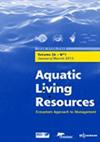Marine protected areas for resilience and economic development
IF 1.9
4区 农林科学
Q3 FISHERIES
引用次数: 0
Abstract
In this research, we attempt to give a comparative analysis of the space allocation of multiple-use marine protected areas (MPAs) including but not limited to the introduction of aquaculture in the area. Specifically, we consider the case where there is a need to develop MPAs for the conservation of the environment and ecological diversity. There is also a prevailing call for the establishment of aquaculture activities within the area to meet societal demands. Although aquaculture has negative externalities on MPAs, it helps to reduce the pressure on the capture fishery and increases the supply of fish. We develop a deterministic bioeconomic model that describes the transition dynamics and interrelationships of the systems. We find an optimal aquaculture size relative to the optimal size of MPAs that maximizes the overall economic and ecological benefits. Using numerical methods we determine the trajectory of optimal solutions, the recovery rate of the stocks in and outside the MPAs, and the expansion rate of the aquaculture. Sensitivity analysis was also performed to see the effect of a change in the parameters on the optimal solutions. The numerical results show that MPAs are resilient after the implementation of aquaculture. Moreover, the effectiveness of the optimized management system mainly depends on the cooperative planning between the capture fishery and aquaculture managers.
海洋保护区的恢复力和经济发展
在本研究中,我们试图对多用途海洋保护区(MPAs)的空间分配进行比较分析,包括但不限于在该地区引入水产养殖。具体地说,我们考虑需要为保护环境和生态多样性而发展海洋保护区的情况。人们还普遍呼吁在该地区开展水产养殖活动,以满足社会需求。虽然水产养殖对海洋保护区有负面的外部性,但它有助于减少对捕捞渔业的压力,增加鱼类的供应。我们开发了一个确定性的生物经济模型,描述了系统的过渡动态和相互关系。我们找到了一个最优的水产养殖规模,相对于最优的海洋保护区规模,使整体经济和生态效益最大化。利用数值方法确定了最优解的轨迹、海洋保护区内外种群的回收率和水产养殖的扩张率。还进行了敏感性分析,以观察参数变化对最优解的影响。数值结果表明,实施水产养殖后,海洋保护区具有恢复力。优化后的管理体系的有效性主要取决于捕捞渔业和养殖管理者之间的协同规划。
本文章由计算机程序翻译,如有差异,请以英文原文为准。
求助全文
约1分钟内获得全文
求助全文
来源期刊

Aquatic Living Resources
农林科学-海洋与淡水生物学
CiteScore
2.30
自引率
0.00%
发文量
10
审稿时长
>24 weeks
期刊介绍:
Aquatic Living Resources publishes original research papers, review articles and propective notes dealing with all exploited (i.e. fished or farmed) living resources in marine, brackish and freshwater environments.
Priority is given to ecosystem-based approaches to the study of fishery and aquaculture social-ecological systems, including biological, ecological, economic and social dimensions.
Research on the development of interdisciplinary methods and tools which can usefully support the design, implementation and evaluation of alternative management strategies for fisheries and/or aquaculture systems at different scales is particularly welcome by the journal. This includes the exploration of scenarios and strategies for the conservation of aquatic biodiversity and research relating to the development of integrated assessment approaches aimed at ensuring sustainable and high quality uses of aquatic living resources.
 求助内容:
求助内容: 应助结果提醒方式:
应助结果提醒方式:


